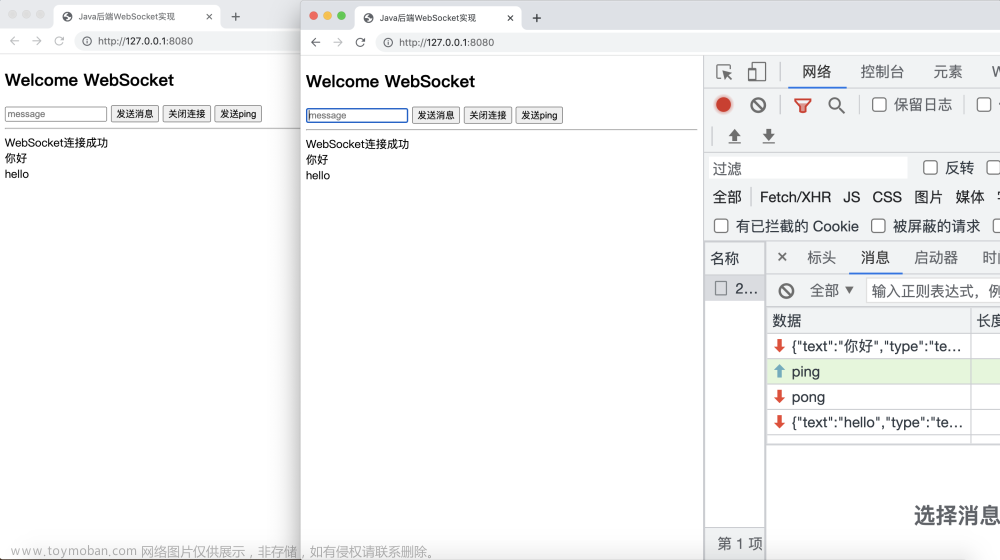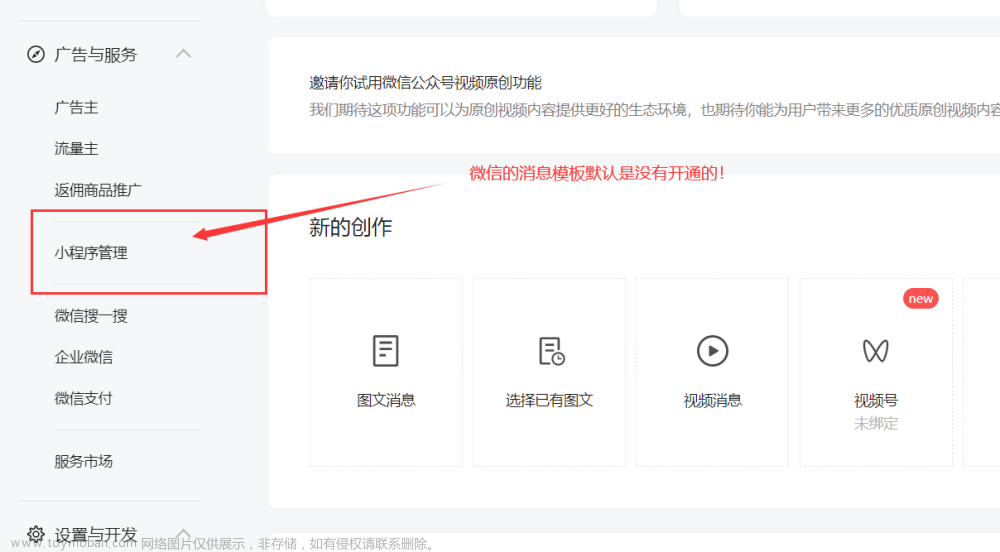我选择的是Server-sent events),简称SSE。主要是我理解起来简单。
这个链接是介绍 几种消息推送的方式java实现web实时消息推送的七种方案--个人学习记录_java实时推送前端数据_自不惘的博客-CSDN博客 文章来源:https://www.toymoban.com/news/detail-680349.html
一、java服务端代码
//SSE:一种服务器发送事件(Server-sent events)
@Slf4j
public class SseEmitterUtil {
//当前连接数
private static AtomicInteger count = new AtomicInteger(0);
//使用 map 对象,便于根据 userId 来获取对应的 SseEmitter,或者放 redis 里面
private static Map<String, SseEmitter> sseEmitterMap = new ConcurrentHashMap<>();
/**
* 创建用户连接并返回 SseEmitter
*
* @param userId 用户ID
* @return SseEmitter
*/
public static SseEmitter connect(Integer userId) {
//设置超时时间,0表示不过期。默认30秒,超过时间未完成会抛出异常:AsyncRequestTimeoutException
SseEmitter sseEmitter = new SseEmitter(0l);
try{
//注册回调:完成、失败、超时
sseEmitter.onCompletion(completionCallBack(userId));
sseEmitter.onError(errorCallBack(userId));
sseEmitter.onTimeout(timeoutCallBack(userId));
// 缓存
sseEmitterMap.put(String.valueOf(userId), sseEmitter);
// 数量+1
count.getAndIncrement();
log.info("创建新的sse连接,当前用户:{}", userId);
}catch (Exception e){
log.info("创建新的sse连接异常,当前用户:{}", userId);
}
return sseEmitter;
}
/**
* 给指定用户发送信息
*/
public static void sendMessage(Integer userId, String message) {
if (!sseEmitterMap.containsKey(userId)) return;
try {
// sseEmitterMap.get(userId).send(message, MediaType.APPLICATION_JSON);
sseEmitterMap.get(userId).send(message);
} catch (IOException e) {
log.error("用户[{}]推送异常:{}", userId, e.getMessage());
removeUser(userId);
}
}
/**
* 移除用户连接
*/
public static void removeUser(Integer userId) {
sseEmitterMap.remove(userId);
// 数量-1
count.getAndDecrement();
log.info("移除用户:{}", userId);
}
/**
* 获取当前连接数量
*/
public static int getUserCount() {
return count.intValue();
}
private static Runnable completionCallBack(Integer userId) {
return () -> {
log.info("结束连接:{}", userId);
removeUser(userId);
};
}
private static Runnable timeoutCallBack(Integer userId) {
return () -> {
log.info("连接超时:{}", userId);
removeUser(userId);
};
}
private static Consumer<Throwable> errorCallBack(Integer userId) {
return throwable -> {
log.info("连接异常:{}", userId);
removeUser(userId);
};
}
}
二、前端代码
目前uniapp不支持EventSource,暂时就是pc端文章来源地址https://www.toymoban.com/news/detail-680349.html
<!DOCTYPE html>
<html lang="en">
<head>
<meta charset="UTF-8">
<title>消息推送</title>
</head>
<body>
<div>
<button onclick="closeSse()">关闭连接</button>
<div id="message"></div>
</div>
</body>
<script>
let source = null;
// 用时间戳模拟登录用户
const userId = new Date().getTime();
if (window.EventSource) {
// 建立连接
source = new EventSource('http://localhost:8080/sse/connect/' + userId);
/**
* 连接一旦建立,就会触发open事件
* 另一种写法:source.onopen = function (event) {}
*/
source.addEventListener('open', function (e) {
setMessageInnerHTML("建立连接。。。");
}, false);
/**
* 客户端收到服务器发来的数据
* 另一种写法:source.onmessage = function (event) {}
*/
source.addEventListener('message', function (e) {
setMessageInnerHTML(e.data);
});
/**
* 如果发生通信错误(比如连接中断),就会触发error事件
* 或者:
* 另一种写法:source.onerror = function (event) {}
*/
source.addEventListener('error', function (e) {
if (e.readyState === EventSource.CLOSED) {
setMessageInnerHTML("连接关闭");
} else {
console.log(e);
}
}, false);
} else {
setMessageInnerHTML("你的浏览器不支持SSE");
}
// 监听窗口关闭事件,主动去关闭sse连接,如果服务端设置永不过期,浏览器关闭后手动清理服务端数据
window.onbeforeunload = function () {
closeSse();
};
// 关闭Sse连接
function closeSse() {
source.close();
const httpRequest = new XMLHttpRequest();
httpRequest.open('GET', 'http://localhost:8080/sse/close/' + userId, true);
httpRequest.send();
console.log("close");
}
// 将消息显示在网页上
function setMessageInnerHTML(innerHTML) {
document.getElementById('message').innerHTML += innerHTML + '<br/>';
}
</script>
</html>
到了这里,关于java Server Sent Event 实现消息推送的文章就介绍完了。如果您还想了解更多内容,请在右上角搜索TOY模板网以前的文章或继续浏览下面的相关文章,希望大家以后多多支持TOY模板网!









